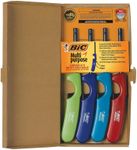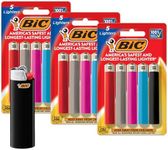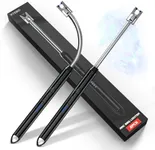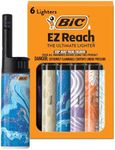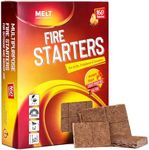Buying Guide for the Best Camping Lighters
Choosing the right camping lighter is essential for a successful and enjoyable outdoor experience. A good camping lighter should be reliable, durable, and easy to use in various weather conditions. When selecting a camping lighter, consider the following key specifications to ensure you pick the best fit for your needs.Ignition TypeThe ignition type refers to how the lighter creates a flame. Common types include flint, piezoelectric, and electronic ignition. Flint lighters require you to strike a wheel to create a spark, which can be reliable but may be difficult in wet conditions. Piezoelectric lighters use a button to generate a spark, making them easier to use but potentially less durable over time. Electronic lighters use a battery to create a spark, offering convenience but requiring battery maintenance. Choose an ignition type based on your preference for ease of use and reliability in different weather conditions.
Fuel TypeCamping lighters can use various fuel types, such as butane, propane, or liquid fuel. Butane lighters are popular for their convenience and clean burn but may not perform well in cold temperatures. Propane lighters are more versatile and perform better in cold weather but can be bulkier. Liquid fuel lighters, like those using white gas, are reliable and perform well in all conditions but require more maintenance. Consider the typical weather conditions and your willingness to maintain the lighter when choosing the fuel type.
Wind ResistanceWind resistance is crucial for a camping lighter, as outdoor conditions can be unpredictable. Wind-resistant lighters are designed to maintain a flame even in strong winds, making them more reliable for outdoor use. Look for lighters with features like a windproof design or a protective casing to ensure they can withstand windy conditions. If you often camp in exposed or windy areas, prioritize a lighter with high wind resistance.
DurabilityDurability refers to the lighter's ability to withstand rough handling and harsh outdoor conditions. A durable camping lighter should be made from robust materials like metal or high-quality plastic and have a solid construction. Waterproof and shockproof features can also enhance durability. If you plan to use the lighter frequently or in challenging environments, choose one with a reputation for durability to ensure it lasts through your adventures.
Size and WeightThe size and weight of a camping lighter can impact its portability and ease of use. Compact and lightweight lighters are easier to carry and store, making them ideal for backpacking or minimalist camping. However, smaller lighters may have a shorter burn time or be less durable. Larger lighters may offer more fuel capacity and durability but can be bulkier to carry. Consider your camping style and how much space and weight you can afford to allocate to a lighter when making your choice.
Burn TimeBurn time refers to how long the lighter can produce a flame before needing a refill or recharge. Longer burn times are beneficial for extended trips or when you need to light multiple fires. However, lighters with longer burn times may be larger or heavier. Assess your typical camping duration and how often you expect to use the lighter to determine the appropriate burn time for your needs.
Ease of RefillingEase of refilling is important for maintaining the lighter's functionality during your trip. Some lighters are designed for easy refilling with readily available fuel canisters, while others may require more effort or specific tools. Consider how often you will need to refill the lighter and the availability of the required fuel when choosing a model. If convenience is a priority, opt for a lighter that is easy to refill and uses common fuel types.
